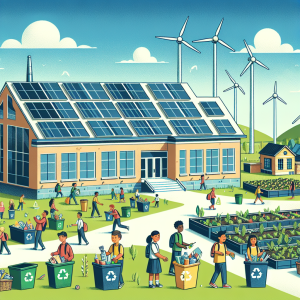Community-Led Initiatives for a Greener World have emerged as powerful mechanisms to drive environmental change, harnessing local knowledge and resources to foster sustainable practices. These grassroots efforts stand at the forefront of tackling global environmental challenges such as climate change, pollution, and biodiversity loss. By empowering residents to take action, community-led initiatives foster a sense of ownership and responsibility towards local ecosystems, resulting in meaningful and lasting impacts.
At the heart of these initiatives is community involvement, where local stakeholders collaborate to identify environmental issues and devise solutions that are culturally and regionally appropriate. This includes organizing clean-up drives, advocating for renewable energy projects, and promoting recycling and waste reduction practices. Such actions not only contribute to ecological preservation but also create social cohesion and instill a shared vision for a sustainable future.
In urban areas, community gardens have gained traction as vital green spaces that offer a reprieve from concrete landscapes while providing fresh produce. These gardens are often managed by neighborhood residents and offer numerous benefits, from improving air quality and supporting biodiversity to reducing food miles and fostering physical activity. They also serve as educational platforms, where community members can learn about sustainable farming practices and nutrition.
Renewable energy projects form another important pillar of community-led initiatives. Local solar and wind energy projects, orchestrated by community cooperatives, demonstrate the potential of transitioning towards green energy. These projects not only reduce reliance on fossil fuels but also create local jobs and keep financial benefits within the community. In some instances, residents even have the opportunity to invest in these projects, ensuring that profits are shared among stakeholders.
Water conservation is another critical area where community-led initiatives are making significant advancements. Rainwater harvesting systems, water-efficient landscaping, and community awareness programs are examples of how local actions can mitigate water scarcity challenges. By involving the community, these initiatives often spark innovation, as residents tailor solutions to fit geographical and climatic conditions.
Moreover, communities often collaborate with local governments and non-governmental organizations to amplify their impact. This collaboration can be seen in efforts to promote sustainable transportation options, such as bike-sharing programs and carpool networks, which help reduce carbon emissions and traffic congestion in urban centers. By ensuring accessibility and affordability, these transportation initiatives can transform commuting habits and lessen the environmental footprint of daily travel.
Waste management is another domain where community-led initiatives have shown remarkable success. Programs focused on reducing, reusing, and recycling are instituted at the community level, involving local participants in activities like composting workshops, swap meets, and zero-waste challenges. These efforts not only help divert waste from landfills but also promote a cultural mindset shift toward sustainability.
Biodiversity conservation also benefits from grassroots efforts. Community-led reforestation and habitat restoration projects are excellent examples of environmental stewardship. By planting native trees and restoring natural habitats, communities help combat deforestation and support local wildlife. These actions often involve partnerships with ecologists who guide projects to ensure ecological balance and biodiversity enhancement.
The digital age further amplifies the power of community-led initiatives. Online platforms and social media have become pivotal in organizing environmental campaigns, spreading awareness, and mobilizing volunteers. Virtual forums allow communities to share success stories, exchange knowledge, and inspire each other, fostering a global network of environmentally-conscious citizens.
A crucial aspect of community-led initiatives is their adaptability. As environmental conditions and societal needs evolve, these grassroots movements have the flexibility to adjust strategies and embrace new technologies. This adaptability is critical in addressing the multifaceted nature of ecological challenges, ensuring that solutions remain relevant and effective over time.
Local education and empowerment are also vital components of these initiatives. By offering workshops, seminars, and educational resources, community-led efforts invest in the knowledge and skills of residents. This emphasis on education helps cultivate a generation that is informed and motivated to continue advocating for environmental sustainability.
Inclusion and diversity within these initiatives is equally important, ensuring that all voices, especially those from marginalized communities, are heard and considered. Environmental justice is a core principle, as these communities are often disproportionately affected by environmental degradation. By prioritizing inclusivity, community-led initiatives ensure equitable solutions that benefit all members.
Financial sustainability is another consideration for the longevity of community-led initiatives. By exploring diverse funding sources such as grants, crowdfunding, and community-sponsored fundraising events, these initiatives can maintain momentum and expand their reach. Financial transparency and accountability further encourage community trust and participation.
Furthermore, the social aspect of community-led initiatives cannot be overlooked. These efforts often lead to the creation of tight-knit networks that not only collaborate on environmental projects but also provide mutual support and resilience in facing broader challenges. The sense of achievement and community pride garnered from these initiatives acts as a catalyst for further action, propelling ongoing and future sustainability endeavors.
In summary, Community-Led Initiatives for a Greener World serve as a testament to the power of collective action and grassroots involvement. By leveraging local knowledge and resources, these initiatives effectively address environmental challenges while simultaneously enhancing community well-being and resilience. Through education, collaboration, and innovation, they pave a path toward a more sustainable and equitable future.




